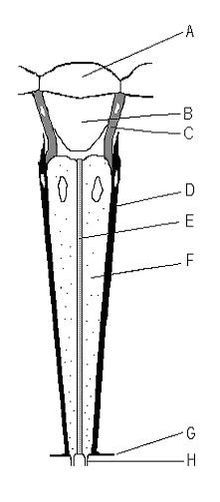- Ommatidium
-
The compound eyes of insects, mantis shrimp and millipedes[1] are composed of units called ommatidia (singular: ommatidium). An ommatidium contains a cluster of photoreceptor cells surrounded by support cells and pigment cells. The outer part of the ommatidium is overlaid with a transparent cornea. Each ommatidium is innervated by one axon and thus provides the brain with one picture element. The brain forms an image from these independent picture elements. The number of ommatidia in the eye depends upon the type of insect and ranges from just a handful in the primitive Archaeognatha and Thysanura to around 30 thousand in larger Anisoptera dragonflies and in some Sphingidae among moths.[2]
Ommatidia are typically hexagonal in cross section, and approximately ten times longer than wide. The diameter is largest at the surface, tapering toward the inner end. At the outer surface there is a cornea, below which is a pseudocone which acts to further focus the light. The cornea and pseudocone form the outer 10% of the length of the ommatidium.
The inner 90% of the ommatidium contains 6 to 9 in the case of some butterflies[3] (depending on the species) long and thin photoreceptor cells often abbreviated "R cells" in literature and often numbered, e.g. R1 through R9.[4] These "R cells" tightly pack the ommatidium. The portion of the R cells at the central axis of the ommatidium collectively form a light guide, a transparent tube, called the rhabdom.
In certain flies, the rhabdom has separated into seven independent rhabdomeres. This has required the rewiring of the eye such that each ommatidium now has seven axons leading from it. The advantage to this arrangement is that it increases the number of picture elements by a factor of seven, without increasing the number of ommatidia.
Since an image from the compound eye is created from the independent picture elements produced by ommatidia, it is important for the ommatidia to react only to that part of the scene directly in front of it. To prevent light entering at an angle from being detected by the ommatidium it entered, or by any of the neighboring ommatidia, six pigment cells are present. The pigment cells line the outside of each ommatidium. Each pigment cell is situated at the apex of the hexagons and thus lines the outside of three ommatidia. Light entering at an angle passes through the thin cross-section of the photoreceptor cell, with only a tiny chance of exciting it, and is absorbed by the pigment cell, before it can enter a neighboring ommatidium. In many species, in low-light situations, the pigment is withdrawn, so that light entering the eye might be detected by any of several ommatidia. This enhances light detection but lowers resolution.
The size of the ommatidia varies according to species, but ranges from 5 to 50 micrometres. The rhabdoms within them may cross-section at least as small as 1.x micrometres, the category of "small" being assigned in some cross-species studies to those under 2 micrometers.[5] Naively, microlens arrays can be seen as a biomimetic analogy of ommatidia.
See also
References
- ^ Carsten H.G. Müller, Andy Sombke & Jörg Rosenberg (2007). "The fine structure of the eyes of some bristly millipedes (Penicillata, Diplopoda) : additional support for the homology of mandibulate ommatidia". Arthropod Structure & Development 36 (4): 463–476. doi:10.1016/j.asd.2007.09.002. PMID 18089122.
- ^ Common, I.F.B., Moths of Australia (Brill, 1990, p 15)
- ^ Briscoe, Adriana, "Reconstructing the Ancestral Butterfly Eye," Journal of Experimental Biology, 2008
- ^ Briscoe, Adriana, "Reconstructing the Ancestral Butterfly Eye", Journal of Experimental Biology, 2008
- ^ Land, Michael S., "Visual Acuity in Insects," (1997)
Categories:- Eye
- Arthropod anatomy
- Insect anatomy
Wikimedia Foundation. 2010.

